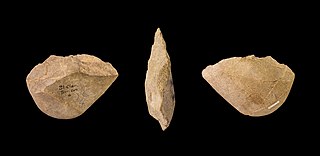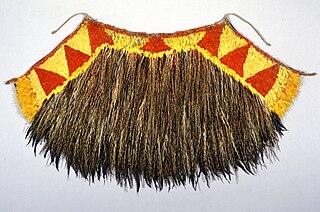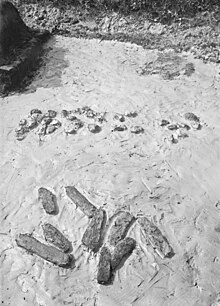
Karelia is a historical province of Finland, consisting of the modern-day Finnish regions of South Karelia and North Karelia plus the historical regions of Ladoga Karelia and the Karelian isthmus, which are now in Russia. Historical Karelia also extends to the regions of Kymenlaakso, Northern Savonia and Southern Savonia (Mäntyharju).

Jarlshof is the best-known prehistoric archaeological site in Shetland, Scotland. It lies in Sumburgh, Mainland, Shetland and has been described as "one of the most remarkable archaeological sites ever excavated in the British Isles". It contains remains dating from 2500 BC up to the 17th century AD.

A fishing net is a net used for fishing. Some fishing nets are also called fish traps, for example fyke nets. Fishing nets are usually meshes formed by knotting a relatively thin thread. Early nets were woven from grasses, flaxes and other fibrous plant material. Later cotton was used. Modern nets are usually made of artificial polyamides like nylon, although nets of organic polyamides such as wool or silk thread were common until recently and are still used.

In archaeology a chopping tool is a stone tool. Stone tools are usually dated by determining the age of the find context e.g. by Carbon 14 dating and Potassium argon dating. The oldest stone tools are about 3 million years old.

The Grianan of Aileach, sometimes anglicised as Greenan Ely or Greenan Fort, is a hillfort atop the 244 metres (801 ft) high Greenan Mountain at Inishowen in County Donegal, Ireland. The main structure is a stone ringfort, thought to have been built by the Northern Uí Néill, in the sixth or seventh century CE; although there is evidence that the site had been in use before the fort was built. It has been identified as the seat of the Kingdom of Ailech and one of the royal sites of Gaelic Ireland. The wall is about 4.5 metres (15 ft) thick and 5 metres (16 ft) high. Inside it has three terraces, which are linked by steps, and two long passages within it. Originally, there would have been buildings inside the ringfort. Just outside it are the remains of a well and a tumulus.

Kamennogorsk, is a town in Vyborgsky District of Leningrad Oblast, Russia, located on the Karelian Isthmus on the left bank of the Vuoksi River 170 kilometers (110 mi) northwest of St. Petersburg. Population: 6,739 (2010 Census); 6,084 (2002 Census); 5,694 (1989 Soviet census).

Denghoog is a Neolithic passage grave dating from around 3000 BC on the northern edge of Wenningstedt-Braderup on the German island of Sylt. The name Denghoog derives from the Söl'ring Deng (Thing) and Hoog (Hill).

Wolf Cave is a crack in the Pyhävuori mountain in Kristinestad, near the Karijoki municipality in Finland. The upper part of the crack has been packed with soil, forming a cave. In 1996, some objects were found in the cave that brought about speculations that it could have been inhabited in the Paleolithic, between 120,000 and 130,000 years ago. These objects, if authentic, would be the only known Neanderthal artifacts in the Nordic countries.

Ancient Estonia refers to a period covering History of Estonia from the middle of the 8th millennium BC until the conquest and subjugation of the local Finnic tribes in the first quarter of the 13th century during the Teutonic and Danish Northern Crusades.
The Subneolithic is an archaeological period sometimes used to distinguish cultures that are transitional between the Mesolithic and the Neolithic. Subneolithic societies typically adopted some secondary elements of the Neolithic package, but retained economies based on hunting and gathering and fishing instead of agriculture. For the most part they were sedentary. The Subneolithic dates to the period 5000/4000–3200/2700 BCE in Scandinavia, north and north-eastern Europe.

Portskewett is a village and community (parish) in Monmouthshire, south east Wales. It is located four miles south west of Chepstow and one mile east of Caldicot, in an archaeologically sensitive part of the Caldicot Levels on the Welsh shore of the Severn Estuary. The Second Severn Crossing passes overhead carrying the M4 motorway. The community includes Sudbrook, Crick and Leechpool.

Menhet, Menwi and Merti, also spelled Manhata, Manuwai and Maruta, were three minor foreign-born wives of Pharaoh Thutmose III of the Eighteenth Dynasty. They are known for their lavishly furnished rock-cut tomb in Wady Gabbanat el-Qurud near Luxor, Egypt. They are suggested to be Syrian, as the names all fit into Canaanite name forms, although their ultimate origin is unknown. A West Semitic origin is likely, but both West Semitic and Hurrian derivations have been suggested for Menwi. Each of the wives bear the title of "king's wife", and were likely only minor members of the royal harem. It is not known if the women were related as the faces on the lids of their canopic jars are all different.
Samrong Sen on the east bank of the Stueng Chinit River is a prehistoric archaeological site in the Kampong Chhnang Province, Cambodia. Consisting of a very large fluviatile shell midden, it flourished in particular from 1500 BC to 500 BC.
Mound 34 is a small platform mound located roughly 400 metres (1,300 ft) to the east of Monks Mound at Cahokia Mounds near Collinsville, Illinois. Excavations near Mound 34 from 2002 to 2010 revealed the remains of a copper workshop, although the one of a kind discovery had been previously found in the late 1950s by archaeologist Gregory Perino, but lost for 60 years. It is so far the only remains of a copper workshop found at a Mississippian culture archaeological site.

The Australian Museum's Cook Collection was acquired in 1894 when it was transferred from the Government of New South Wales. At that time it consisted of 115 artifacts collected on Captain James Cook's three voyages of discovery Throughout the Pacific Ocean, during the period 1768–1780, along with documents and memorabilia related to these voyages. Many of the ethnographic artifacts were collected at a time of first contact between Pacific Peoples and Europeans. In 1935 most of the documents and memorabilia were transferred to the Mitchell Library in the State Library of New South Wales. The provenance of the collection shows that the objects remained in the hands of Captain James Cook's widow, Elizabeth Cook and her descendants until 1886. In this year John Mackrell, the great nephew of Isaac Smith, Elizabeth Cook's cousin, organized the display of this collection at the request of the NSW Government at the Colonial and Indian Exhibition in London. In 1887 the London-based Agent-General for the New South Wales Government, Saul Samuel, bought John Mackrell's items and also acquired those items belonging to the other relatives Reverend Canon Frederick Bennett, Mrs Thomas Langton, H.M.C. Alexander and William Adams. The collection remained with the Colonial Secretary of NSW until 1894, when it was transferred to the Australian Museum.

Saruq Al Hadid is an archaeological site in Dubai, United Arab Emirates (UAE), and stands as one of the most important and enigmatic historical sites in the country. Findings from the site are displayed in a museum with the same name in the city of Dubai. The site was originally discovered by the ruler of Dubai, Sheikh Mohammed bin Rashid Al Maktoum, while flying his helicopter across the desert.

In many areas of Scandinavia, a wide variety of items were deposited in lakes and bogs from the Mesolithic period through to the Middle Ages. Such items include earthenware, decorative metalwork, weapons, and human corpses, known as bog bodies. As Kaul noted, "we cannot get away from the fact that the depositions in the bogs were connected with the ritual/religious sphere."
Matupi Cave is a cave in the Mount Hoyo massif of the Ituri Rainforest, Democratic Republic of the Congo, where archaeologists have found evidence for Late Stone Age human occupation spanning over 40,000 years. The cave has some of the earliest evidence in the world for microlithic tool technologies.
Frog coffins are burials of frogs in miniature coffins in Finland for the purposes of folk magic. These coffins are known from finds secreted in churches, as well as from references to their use in folk magic at other locations.

Aigyr-Zhal 2 is a historical site in Naryn city on the territory of University of Central Asia (UCA), Kyrgyzstan. It is a part of a bigger and more complex site Aigyr-Zhal. It is dated between Mesolithic time and the Middle Ages. Aigyr-Zhal is the only site in the Tian-Shan that has evidence of human occupation from Mesolithic time till the Turkic period . It was first discovered in 1953 by Akhmat Kibirov. However, during the Soviet time the site was partially destroyed, therefore it was impossible to research the site for a long time. Only in 2012 it was first researched by Kubat Tabaldiev's archaeological team. The length of Aigyr-Zhal 2 is 300 metres, while the width is 100 metres, and the height of the site is 2026 metres above the sea level. Since 2002 the whole Aigyr-Zhal complex has been on the list of national importance of Kyrgyzstan.
















